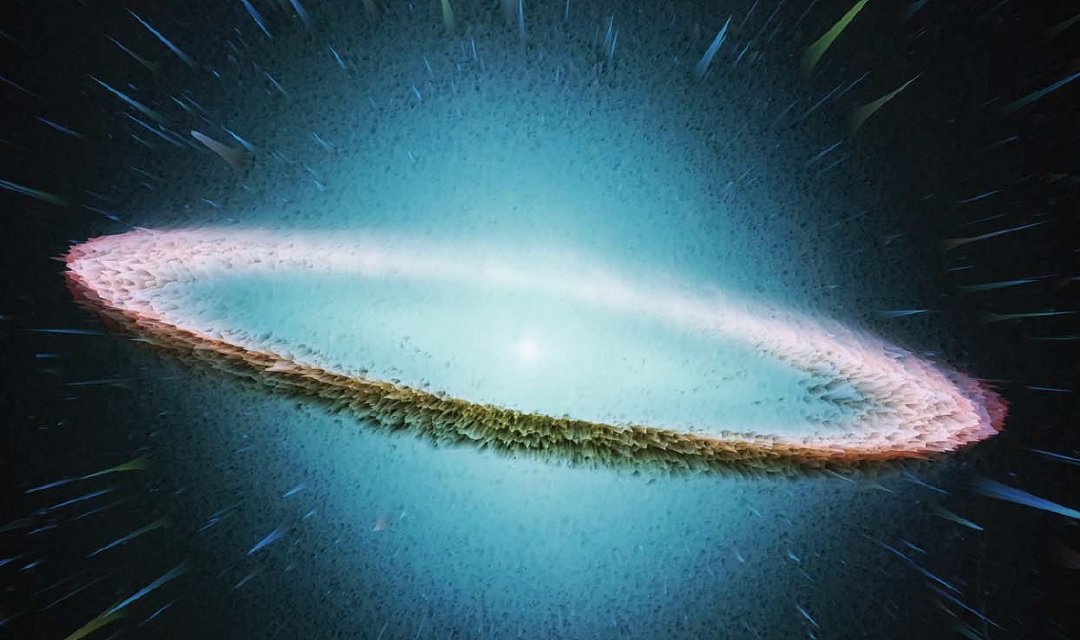This article first appeared in the Christian Research Journal volume 43, number 03 (2020). For more information about the Christian Research Journal, click here.
Synopsis
Scientific materialists recognize that an intellectually satisfying worldview must account for the entirety of human experience. A previous article explored how various contemporary authors attempt to explain the quintessentially human intuition that our existence has meaning, purpose, and value, and argued that their efforts inevitably fail. In addition to providing a foundation for the indispensable intangibles that make life worth living, a viable worldview must include plausible explanations for major origin events — the origin of the universe, the origin of life, and the origin of consciousness. The latest popular level scientific materialist manifestos written by prominent public figures who specialize in fields such as astrophysics and cosmology include extensive discussions of these so-called singularities in cosmic and biological history — presenting the current naturalistic theories for the various origin events. However, they do so with a veneer of unwarranted optimism. They regard these abysses as temporary obstacles to a comprehensive scientific narrative and proffer an unwavering faith that researchers will eventually cross them. Some writers are more transparent than others in terms of their philosophical commitment to a reductionist, materialist understanding of the natural world and suggest that permanent mystery is vastly superior to positing the involvement of a transcendent intelligence. This is particularly evident in treatments of the origin of life problem. Further, these writers fail to acknowledge that plausible scientific explanations, should such be forthcoming, do not diminish the case for a Designer of life.
In recent years, several prominent scientists have published what could be thought of as scientific materialist manifestos — books that attempt to account for everything known to humankind without resorting to transcendent intelligent agency (i.e., God) as an explanation. These intellectuals realize that a viable worldview must provide — or show signs of eventually providing — a satisfying answer to the “big questions” of existence. What caused the igniting spark that brought the cosmos into being? How did life begin? What about consciousness and rationality? Whence comes meaning, value, and purpose? A previous article addressed the last question by arguing that, contrary to the assertions made in recent manifestos, scientific materialism has no room within its philosophical confines for the intangibles that make life worth living.1 The remaining questions represent what have been collectively called the great singularities — the origin of the universe, the origin of life, and the origin of mind. In The Everlasting Man (1925), G. K. Chesterton used the imagery of a bridge built over a massive “abyss of the unthinkable” to describe each of these mysterious, monumental transitions in cosmic history. For Chesterton, God was the engineer of each bridge: from nothing to something, from inanimate matter to life, and from biological automata to sentience and rationality.
These three singularities continue to defy naturalistic explanation — a fact that is severely downplayed by recent scientific materialist manifestos, which contend that there are merely a few trifling details left to work out. Besides, suggesting that there is a divine Mind responsible for natural phenomena is to commit the fallacy known as “god of the gaps”2 (or “god of the abysses,” to continue the previous metaphor), so the argument goes. But it seems fair to ask: what if there truly were chasms in the path of natural history that blind material processes were incapable of traversing? To deny this possibility a priori — independent of empirical investigation — seems intellectually irresponsible.
In a future article, I will explore how writers of scientific materialist manifestos contend that advancement in scientific knowledge has undermined the case for the immaterial soul, leaving no plausible means for accounting for consciousness, rationality, and free will. In what follows, I’ll examine the claim that intelligent agency is unnecessary for a solution to the origin of life problem.
We Know It Can Happen Because It Did?
The structure and function of a living cell are dictated by the genetic information stored in the double-stranded, helical DNA molecule. The translation of this information into the protein products necessary for cellular structure and function involves the transcription of the code into a single-stranded RNA molecule, which is used to construct a chain of amino acids. This chain folds into a complex three-dimensional shape — the finished protein molecule — based upon the sequence specificity of the constituent amino acids. This geometry determines the protein’s function. Thus, from DNA to RNA to protein, the order of parts is essential. Explaining the origin of the first life involves, in part, explaining the origin of the information that makes this process possible.
In his book, Until the End of Time: Mind, Matter, and Our Search for Meaning in an Evolving Universe, physicist Brian Greene devotes an entire chapter to the question of life’s origin. Greene acknowledges that the problem remains unsolved: “While there has been impressive progress in decomposing life (and matter more generally) into its constituent parts, researchers still face the formidable task of laying out how life emerges when collections of these constituents are arranged in particular configurations.”3 Yet Greene is convinced that “even without a complete understanding we can turn to an explanatory framework — Darwinian evolution — that will almost certainly be an integral part of that future narrative.”4 What he means is that the eventual solution to the origin of life problem will likely involve a selection mechanism that operated at the chemical level, analogous to the manner in which Darwinian natural selection operates at the biological level. This scenario must include replication since selection cannot occur without it. Greene suggests that, on the primordial Earth, certain molecules were hardier than others and thus more likely to “survive” in their environment and promote the formation of copies:
Imagine…a molecule that can replicate on its own, long before any life anywhere has emerged. We don’t need to commit to a definite replication mechanism, but just so you have a concrete mental image, perhaps when floating in a rich chemical stew this type of molecule acts like a molecular magnet, strongly attracting the very constituents that compose it and providing a template to assemble them into a molecular impersonator. Imagine, too, that the replication process, like all processes in the real world, is imperfect….So as our ecosystem of molecules continues to replicate, those that replicate most efficiently and accurately…will prevail.5
In this hypothetical scenario, chemical reactions increase the quantity of a particular molecule or molecules, while quantities of other molecules are defeated in the competition for chemical resources. Greene claims that this “shows how groups of jostling particles guided solely by the laws of physics can become ever more adept at reproduction — something we ordinarily associate with life.”6
A Chicken-and-Egg Problem
The scientific materialist seems to be under the impression that a chemical reproduction and selection scenario is a great start to building a bridge over the abyss that separates non-living chemicals from the first living cell. Arguably, however, such scenarios only move us closer to the edge of the abyss, where plausible explanations involving chemical selection come to an impasse: the origin of the digital information that codes for functional proteins, which are essential components of life. A molecule that can serve as a medium for biological information is one thing, but the specified complexity of the functional information that must be encoded in the molecule is a far different ball of wax. You may have all the paper and ink necessary for printing a novel, but that doesn’t do anything to explain meaningful sentences on a page, much less organized paragraphs and chapters that are orchestrated into a coherent narrative.
DNA is the self-replicating molecule that codes for the manufacturing of specific proteins in living cells, but its replication requires complex protein machinery. This presents a chicken-and-egg problem when it comes to explaining the emergence of life. Perhaps the leading theory for circumventing this roadblock is the so-called RNA-world hypothesis. In his book, The Big Picture: On the Origins of Life, Meaning, and the Universe Itself, Sean Carroll explains:
When DNA gets copied, an important part of the work is done by proteins. But the proteins are supposed to be constructed using information encoded in the DNA. How could either one arise without the other already being present?.…RNA could have come along before either DNA or proteins, and served as the basis for a primitive and less robust form of early life, before evolution gradually distributed responsibilities to the more effective DNA and proteins….Ribozymes, discovered in the 1980s, are a particular kind of RNA that can catalyze their own synthesis, as well as that of proteins….If you want to get life started from a replication-first perspective, you need a molecule that can carry genetic information without relying on other complex mechanisms to reproduce itself. RNA seems to hit the sweet spot.7
Carroll goes on to give an example of how origin of life researchers have manipulated isolated populations of RNA molecules to initiate a chemical selection process that results in the “fitter” molecules persisting more successfully. Then he explains how other researchers have created a system of specialized RNA — ribozymes that “without any help from surrounding proteins or other biological structures…are able to completely duplicate each other in about an hour. Even better, the molecules occasionally mutate, and therefore undergo Darwinian evolution, with the more fit structures preferentially surviving.”8
Make no mistake, however; this intelligently designed process doesn’t solve or even mitigate the origin of information problem — not by a long shot. Certain digital information must be built into the sequencing of ribozymes to have these capabilities, and the origin of that information is what needs to be explained. Moreover, a molecule encoded with enough information to carry out a replication function is still light years away from the formation of a living cell, which involves an exponentially greater amount of specialized information needed to produce the finely-tuned structures that run the complex biochemical reactions essential to life. Carroll admits that current origin of life theories, including the RNA-world hypothesis, may or may not be correct, but he remains entirely optimistic: “There is no reason to think that we won’t be able to figure out how life started.”9 Yet this attitude seems unjustified given the utter lack of progress in solving the biological information enigma.10
Greene adopts a similar approach and attitude on the origin of life issue. After outlining the RNA-world hypothesis, he acknowledges that RNA and its digital coding is the missing piece but glosses over its cruciality. He writes:
The RNA World is but one of numerous proposals….Should the proposal prove correct, we would still need to address the origin of RNA itself; perhaps an even earlier stage of molecular evolution might have generated RNA from yet simpler chemical constituents….Once molecules acquire the capacity to replicate, chance errors and mutations will feed molecular Darwinism, driving chemical concoctions along the all-important vector of increased fitness. Playing out over hundreds of millions of years, the process has the capacity to build the chemical architecture of life.11
He goes on to say that, based upon the power of “molecular Darwinism” operating in a population of replicating molecules, “we can envision how some might acquire the capacity to store and transmit information….Acting out over hundreds of millions of years, these processes may have gradually sculpted the first life.”12
An Extraordinarily Severe Problem
Greene seems to be making two huge assumptions: 1) the compilation of the precise information necessary for a replicating RNA molecule is merely a detail, and 2) once such a molecule emerges, a Darwinian process (and the span of time in which it had to work its magic) is entirely sufficient to explain all the rest. However, this is an almost comical overstatement, considering the astronomical amount of viable information necessary to construct even the simplest known unicellular organism and the slow pace at which beneficial mutations are known to arise and be preserved in populations, much less accumulate and collaborate in the orchestrated fashion necessary for essential cellular machinery and, eventually, increasingly complex organisms.13 Greene’s statement about being able to “envision” a materialist, reductionist account of abiogenesis (the emergence of life from dead chemicals) belies the severity and complexity of the problem. One may suspect that this confidence in the existence of a naturalistic scenario is philosophical, rather than scientific: “Life exists, and since scientific materialism is true, there must be an explanation that doesn’t invoke intelligent design.”
The apparent optimism of scientific materialists regarding the hope for a naturalistic, reductionist solution to the origin of life mystery is unwarranted. The aforementioned information enigma is the abyss that must be leapt, and naturalistic scenarios don’t even have a running start. In a recent essay entitled “Evidence of Intelligent Design in the Origin of Life,” Stephen C. Meyer explains that “the RNA-world hypothesis presupposes, but does not explain, the origin of sequence specificity or information in the original functional RNA molecules…. Some RNA-world advocates seem to envision leapfrogging the sequence-specificity problem.”14 The origin of life theorist must address the central issue: how the “digits” — the nucleotide base pairs that made up the first replication-capable RNA molecule — came to have the digital sequence required for its basic functionality. The limited amount of RNA “self-replication” that has been achieved in origin of life laboratories has involved extensive and precise intervention. As palaeobiologist Simon Conway Morris has aptly put it, these researchers have used “an experimental rig in which the hand of the researcher becomes, for all intents and purposes, the hand of God.”15 Put another way: intelligent design was involved.
Contrary to the impression they attempt to convey, scientific materialist manifestos have not provided adequate reasons to believe that their paradigm is sufficient for making headway with the origin of life problem. In actuality, the problem continues to be an impassible abyss for scientific materialism. As Eugene Koonin, a specialist in evolutionary genomics, has put it, the “‘dirty,’ rarely mentioned secret” is that
Despite many interesting results to its credit, when judged by the straightforward criterion of reaching (or even approaching) the ultimate goal, the origin of life field is a failure — we still do not have even a plausible coherent model, let alone a validated scenario, for the emergence of life on Earth. Certainly, this is due not to a lack of experimental and theoretical effort, but to the extraordinarily intrinsic difficulty and complexity of the problem. A succession of exceedingly unlikely steps is essential for the origin of life…[steps that] make the final outcome seem almost like a miracle.16
Koonin’s remarks stand in stark contrast to the fanciful picture painted by writers like Greene and Carroll. Far from constituting a “god of the gaps” explanation — an argument from ignorance — the appeal to an intelligent Designer of life is a warranted conclusion drawn from mounds of data.
A Designer of Life: Friend to Science
The scientific materialist is loath to consider the involvement of a transcendent Designer; such a thing is considered the gravest mortal sin against scientific thought. For many, it is the idea of divine intervention in the natural order that is so repugnant. This is the idea that an intelligent agent miraculously intervened in the natural order to spontaneously form the first living organism or array of organisms. Carroll writes, “No serious scientist working on the origin of life, even those who are personally religious, points to some particular process and says, ‘Here is the step where we need to invoke the presence of a nonphysical life-force, or some element of supernatural intervention.’ There is a strong conviction that understanding abiogenesis is a matter of solving puzzles within the known laws of nature, not calling for help from outside of them.”17 However, the interventionist theory is not the only option for the proponent of design. Alternatively, one might take a noninterventionist route by acknowledging that life emerged over time through a long series of “exceedingly unlikely steps,” and the very fact that this occurred against all odds and with such incredible and beautiful success is powerful evidence for an intelligent orchestration of nature. In other words, elucidating a plausible mechanism does nothing to undercut the design hypothesis. Asa Gray, the Harvard botanist and design proponent who was Charles Darwin’s most avid American supporter following the publication of On the Origin of Species (1859), offered a clever analogy to make this point:
Recall a woman of a past generation and show her a web of cloth; ask her how it was made, and she will say that the wool or cotton was carded, spun, and woven by hand. When you tell her it was not made by manual labor, that probably no hand has touched the materials throughout the process, it is possible that she might at first regard your statement as tantamount to the assertion that the cloth was made without design. If she did, she would not credit your statement. If you patiently explained to her the theory of carding-machines, spinning-jennies, and power-looms, would her reception of your explanation weaken her conviction that the cloth was the result of design? It is certain that she would believe in design as firmly as before, and that this belief would be attended by a higher conception and reverent admiration of a wisdom, skill, and power greatly beyond anything she had previously conceived possible.18
In this same vein, science and religion scholar and mathematician John Lennox has remarked, “The existence of mechanisms and laws is not an argument for the absence of an agent who set those laws and mechanisms in place. On the contrary, their very sophistication…is evidence for the Creator’s genius.”19 One might think of this as a different level of design argumentation, one that any philosophically astute and open-minded scientist should be willing to explore and even celebrate.
An example of a highly credentialed scientist coming to appreciate this line of thinking is Sy Garte, a biochemist with over 200 publications. In his book, The Works of His Hands, Garte writes of being struck by a powerful sense of wonder at the mystical majesty of life, a sensibility that was magnified by his education and work in biochemistry. He sees a Master behind the mechanisms of life, particularly the marvels of the DNA–RNA–protein production process; he says, “even assuming that God is the Author of the code and of life (which I do assume), there may still be a discoverable natural mechanism by which God acted to create. All of nature is created by God, including everything for which we have found natural mechanisms.”20
A Philosophical Pipe Dream
Ultimately, the scientific materialists’ optimistic expectation that there will eventually be a plausible origin of life theory that definitively rules out genuine design is a pipe dream. The more we learn about the intricate marvels of life, the more overwhelming the impression of ingenious bioengineering becomes. Yet proponents of scientific materialism have no choice but to continue holding out hope for a design-free route for crossing the abyss. We need to see this worldview for what it is: a staunch philosophical position that is independent of anything science will ever discover.
Melissa Cain Travis, PhD, is an assistant professor of Christian apologetics at Houston Baptist University and author of Science and the Mind of the Maker: What the Conversation Between Faith and Science Reveals About God (Harvest House, 2018). www.melissacaintravis.com
NOTES
- Melissa Cain Travis, “Scientific Materialist Manifesto: The Pursuit of Meaning in a Godless Universe,” Christian Research Journal 43, no. 2 (2020): 30–34.
- Plugging divine agency into present deficiencies in scientific knowledge.
- Brian Greene, Until the End of Time: Mind, Matter, and Our Search for Meaning in an Evolving Universe (New York: Alfred A Knopf, 2020), 69.
- Greene, Until the End of Time, 96.
- Greene, Until the End of Time, 101.
- Greene, Until the End of Time, 102.
- Sean Carroll, The Big Picture: On the Origins of Life, Meaning, and the Universe Itself (New York: Dutton, 2016), 267–68.
- Carroll, The Big Picture, 269.
- Carroll, The Big Picture, 270.
- A phrase used by intelligent design theorist Stephen C. Meyer.
- Greene, Until the End of Time, 104, 105.
- Greene, Until the End of Time, 113.
- For an extensive discussion of the origin of information in the context of the evolutionary time scale, see William Ewert, et al., “Time and Information in Evolution,” Bio-Complexity, vol. 2012, no. 4:1–7, https://bio-complexity.org/ojs/index.php/main/article/view/BIO-C.2012.4/BIO-C.2012.4.
- Stephen C. Meyer, “Evidence for Intelligent Design in the Origin of Life,” in Charles Thaxton, et al., The Mystery of Life’s Origin: The Continuing Controversy (Seattle: Discovery Institute, 2020), 447.
- Simon Conway Morris, Life’s Solution: Inevitable Humans in a Lonely Universe (New York: Cambridge University Press, 2003), 41.
- Eugene V. Koonin, The Logic of Chance: The Nature and Origin of Biological Evolution (Upper Saddle River, NJ: FT Press, 2012), 391.
- Carroll, The Big Picture, 270.
- Asa Gray, Darwiniana: Essays and Reviews Pertaining to Darwinism (New York: D. Appleton and Co., 1876), Kindle location 966.
- John Lennox, “Science and Faith: Friendly Allies, Not Hostile Enemies,” Knowing and Doing (Winter, 2015), 12, C. S. Lewis Institute, https://www.cslewisinstitute.org/Science_and_Faith_Friendly_Allies_Not_Hostile_Enemies_FullArticle.
- Sy Garte, The Works of His Hands: A Scientist’s Journey from Atheism to Faith (Grand Rapids: Kregel Publications, 2019), 105.









